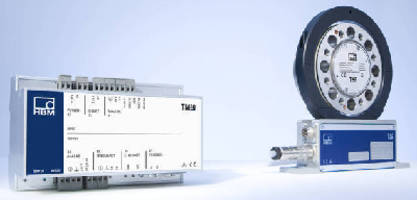Measurement Flange comes in 2 standard torque ranges.
Press Release Summary:

Available with nominal torques of 5 and 10 kNom, T40 torque flange has compact design that facilitates integration in test bench and copes with impact/vibration. Data transmission between rotor and stator is digital, ensuring error-free measured value acquisition and transmission even under difficult ambient conditions involving EMI or fluctuating temperatures. Maintenance-free design employs no slip rings or bearings, and measured torque can be output via voltage or frequency output.
Original Press Release:
The All-Rounder for Measuring Torque at an Optimal Price - the T40 Torque Flange with Increased Measurement Ranges
The all-rounder for measuring torque - at an optimal price - the T40 torque flange from HBM is now available with two new nominal (rated) torques of 5 kNom and 10 kNom The T40 measurement flange series therefore now covers the nominal torque ranges from 500 Nom to 10 kNom and can be used for practically all test bench applications. The compact design of the T40 simplifies integration in a test bench. The torque flange is extremely robust and copes with very large impact and vibration loads. As per EN 60068-2-6, the vibrational stress was tested in all three spatial directions. The T40 had to withstand accelerations of up to 20 g for two and a half hours in the frequency range 10 Hz to 2 kHz. Data transmission between rotor and stator is digital in the T40, so that secure, error-free measured value acquisition and transmission is possible even under difficult ambient conditions, for example electromagnetic interference or fluctuating temperatures. In addition, the measurement flange does not use slip rings or bearings and is therefore totally maintenance and wear-free. This results overall in very high reliability that leads to significantly reduced test bench down times.
The measured torque can be output either via a voltage output or a frequency output. The interface module TIM 40 can be used to supplement the torque flange with even more interfaces. This provides the user with additional independent analog outputs (frequency, 0...±10 V, 4...20 mA). In addition, the interface module enables integration into Ethernet networks as well as connection to the fieldbuses CANopen and Profibus DP.
Typical application areas for the torque flange can be found mainly in the automotive industry for engine, gear or chassis test benches. The T40 can also be used in the testing of electric motors, pumps and generators.
For more information, go to http://www.hbm.com/torque.




